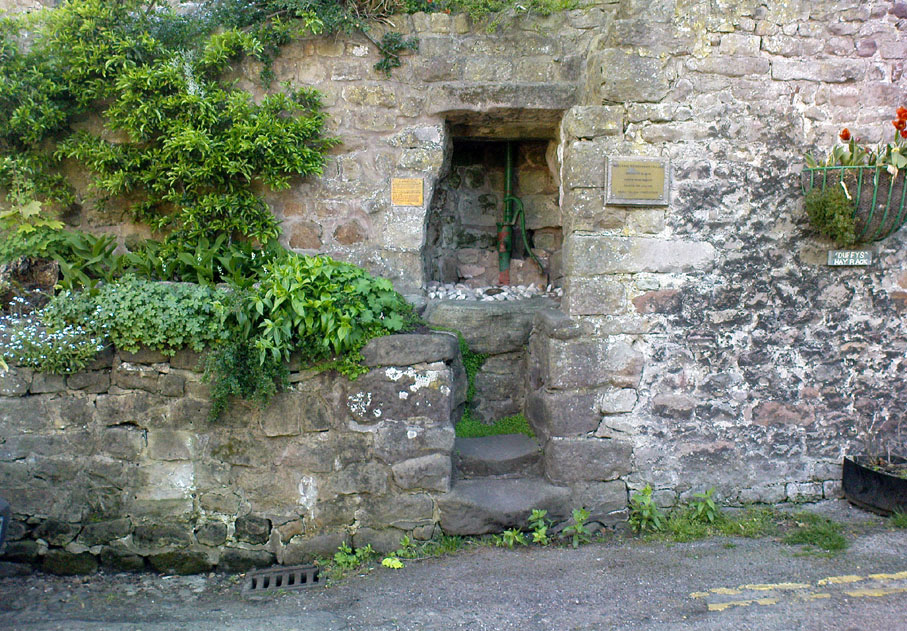Holy Well: OS Grid Reference – SD 4109 6159
From Heysham village centre by the little roundabout, go down the gorgeous olde-worlde Main Street for about 150 yards, keeping your eyes peeled for the little track up to the tree-lined church of St. Peter. Just before going up the path to the church, set back at the roadside, you’ll see an old pump in an arch in the walling. That’s St. Patrick’s Well!

Archaeology & History
Not to be confused with another St. Patrick’s Well a few miles north of here, little has been said of this old holy well in literary tomes (even Henry Taylor’s (1906) magnum opus missed it!) Sadly the waters here have long since been diverted (which violates religious tradition, quite frankly), and all we see today is an old iron water-pump set inside a stone arch, beneath which – I presume – the waters once ran. An old plaque on the site of this ancient well tells:
“This is one of two holy wells in Heysham village (the other, Sainty Well, is on private property and covered over), whose dedications are long since lost. Latterly the water from this well was used for utilitarian gardening purposes within the confines of the old rectory.
“Previously the well had fallen into disuse, suffered from surface contamination and became rubble-filled when the bank above gave way in the mid-1800s. In the early 1900s, the well-head was again rebuilt and the well itself was cleaned and made safe by capping with concrete. Recently (May 2002) the well-head has been refurbished and water artificially introduced, thus turning a derelict area into a feature of the village.”
It would be good if local people could complain to the regional water authority and make them redirect the waters beneath the well, back to the surface, to allow devotees — both Christian and otherwise — to partake of the holy blood sanctified by St. Patrick many centuries ago. And without fluoride or other unholy chemical compounds that desecrate our waters. Just the sacred waters of God’s Earth please!
Folklore
This is one of the many places in the British Isles where St. Patrick was said to have landed after he’d converted all the Irish into the christian cult! One of the traditions was that St. Patrick said the well would never run dry — which was shown to be untrue when the waters were filled in with rubble in the 19th century. The same saint also used the waters from the well to baptise and convert the peasants of his time.
References:
- Quick, R.C., Morecambe and Heysham, Past and Present, Morecambe Times 1962.
© Paul Bennett, The Northern Antiquarian
Hi Paul, I noticed there is a typo at the top of this article – Getting Here – you’ve put Heyshaw instead of Heysham. Thought I’d better let you know. Also, are you aware of the Saxon stones in the churchyard and the rock-cut tombs beside St Patrick’s Chapel. Worth a mention. Ray.
Hi Ray – Thanks for telling me about the typo! (if you see others please lemme know) Re the churchyard crosses and tombs: I was doing the write-up for one of the crosses earlier & have some decent photos aswell. I’ll get the site added in the coming few days. The rock-cut tombs are very intriguing aswell. I wasn;t sure whether to add them as a site – but mebbe they should be included, as they are impressive and pretty unique.
All the best – Paul
Hi, I’m finding your site really interesting, thanks for putting so much great information on here 🙂
I love Heysham, it’s one of the most peaceful places I’ve ever been to. I’m trying to research its folklore right now for a project on the evolution of faeries from forgotten deities. I’m convinced there is a lot more to Heysham than meets the eye – for example there’s the faerie chapel rock formation and faerie steps nearby, so many carved stones, the evidence of both Celtic and Neolithic (I think) settlements there. And someone said there is a long barrow and a round barrow? Is that right? But they’ve never been excavated. I’m really struggling to earth up any local folk tales though (other than the Patrick stuff obviously). If you know of any more information about Heysham that might help I’d be immensely grateful!
Thanks again for such an informative site, blessings, Bia
I have a photo of the well somewhere – a close-up view. Must look it up!